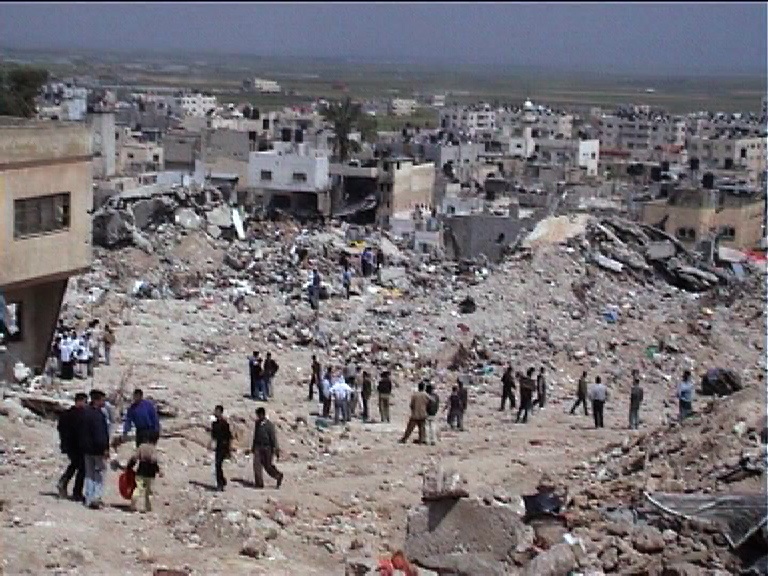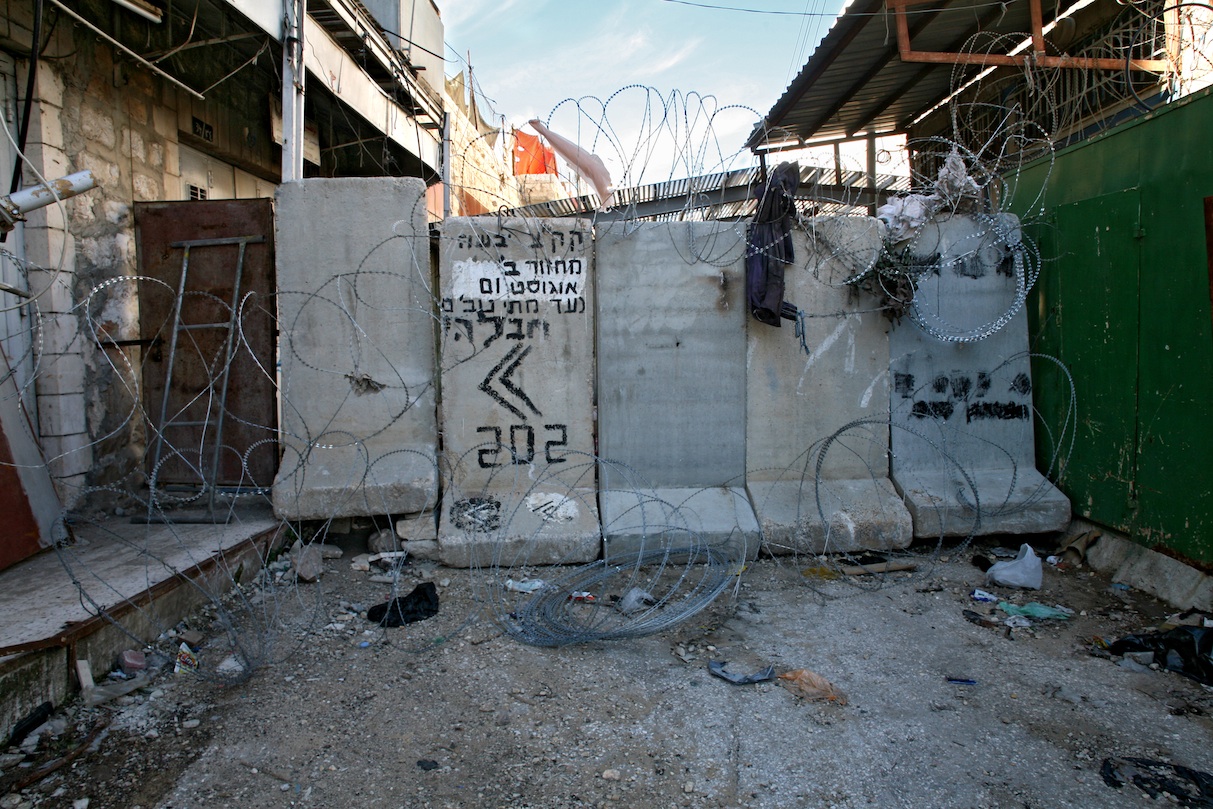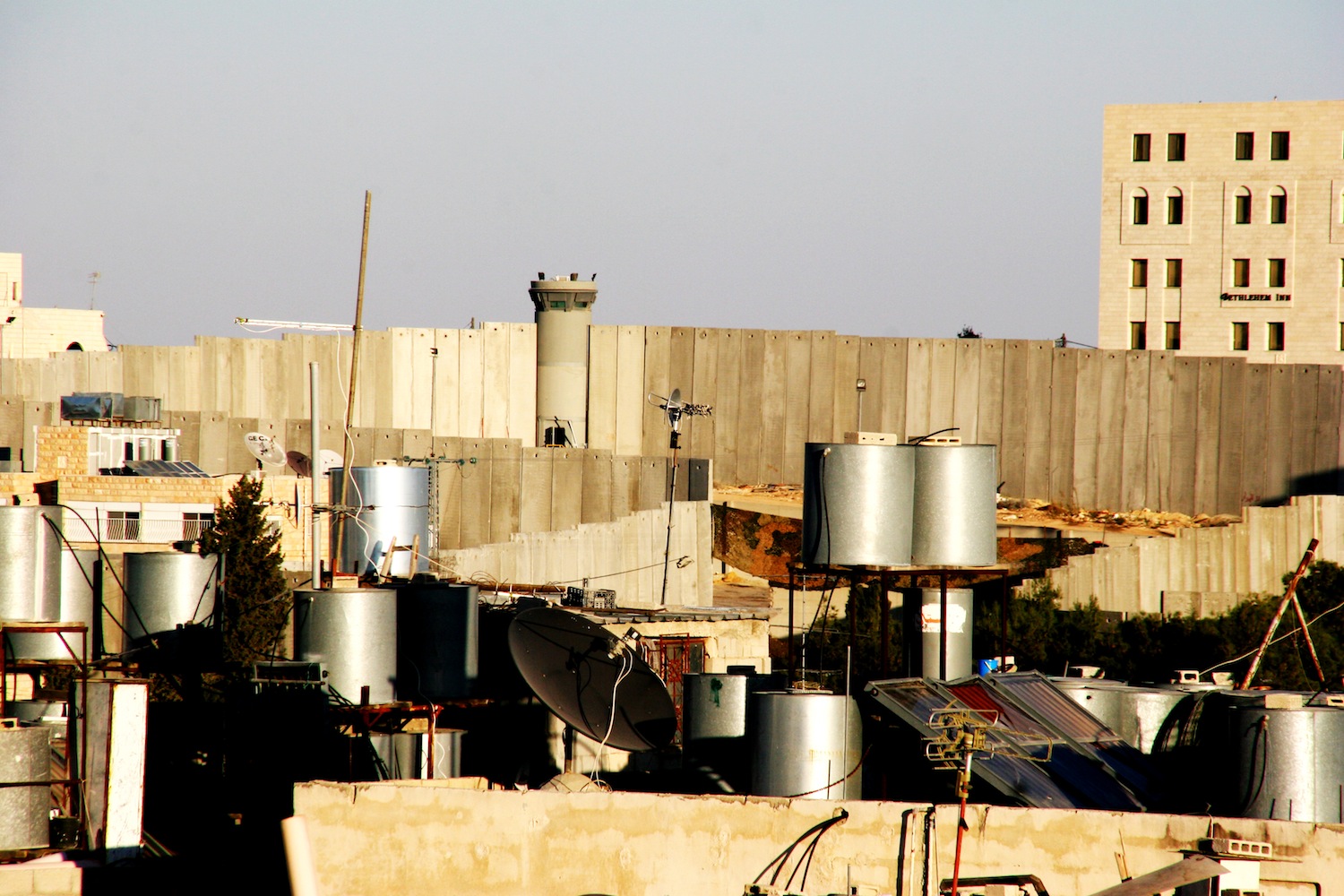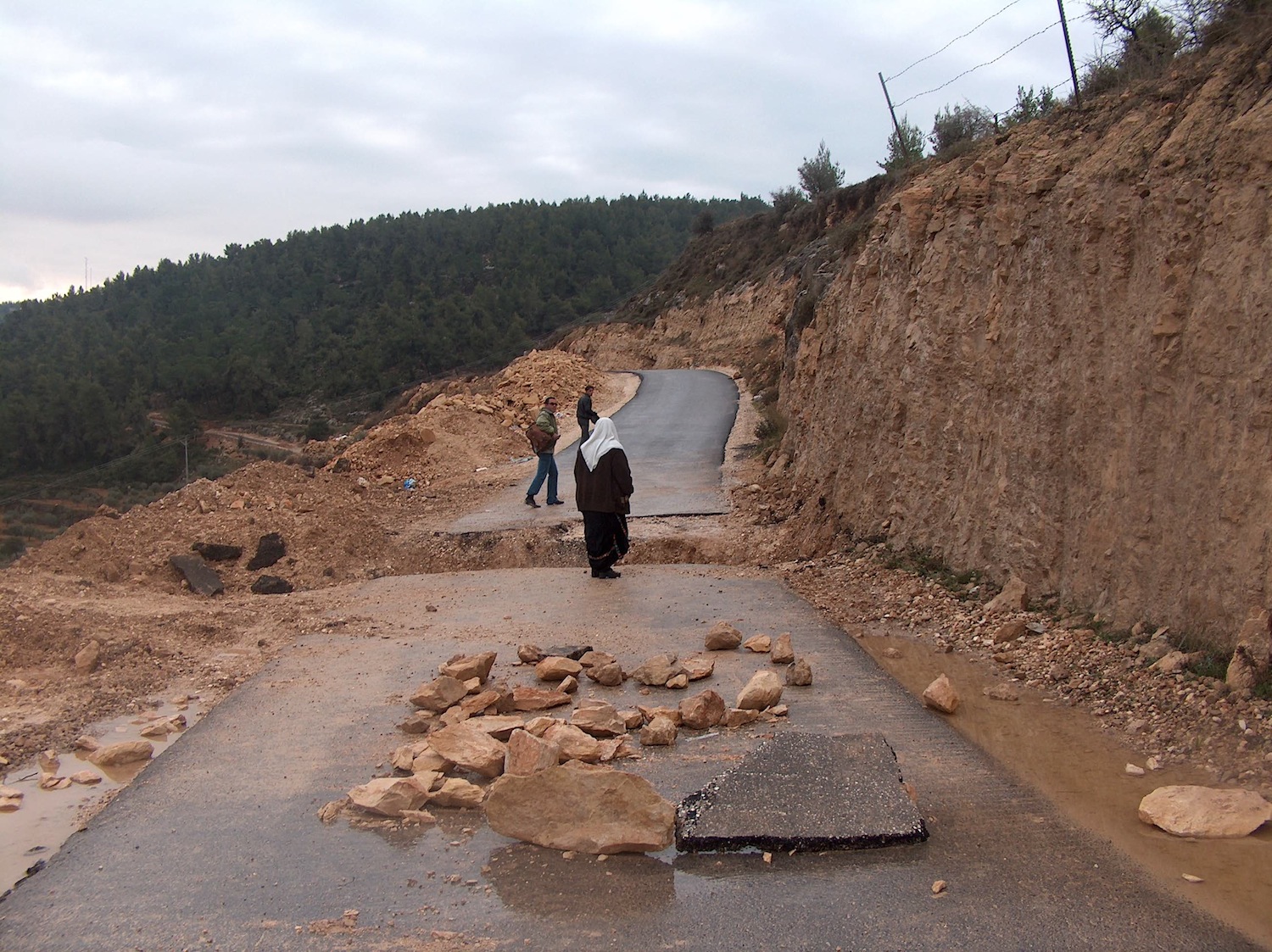The image of the sovereign as a founder of cities who imports architects and engineers farand wide to help him leave his own stamp in space is familiar to us from ancient history. Something of this dimension of ruling power is perpetuated in our times by the sovereign’s
right to initiate and build monuments that transform urban space, and to do so without any
competition, contract or civil consent.
Such architectural privilege, in modern France, for example, belongs to the president of the republic and has an explicit monarchic connotation: fait du prince. In a democratic state, the sovereign may enjoy this privilege only as long as he makes measured and careful use of it. In such states, the monument glorifies the president through the pleasure and benefit he extends to the general citizenry.
In the forty years of its rule, the Occupation regime has made extensive use of this privilege reserved for the sovereign, massively disrupting Palestinian space through three forms of intervention: construction, administration of movement, and destruction. The fact that the Israeli Occupation rule is not recognized as sovereign and its subjects do not recognize its authority has not kept it from expecting absolute and sweeping application of this privilege, while depriving the subjects of any status that would allow them to negotiate their habitat. In each of these three forms, the Occupation regime has conducted itself as a foreign rule whose sole purpose is to establish its control and possession of space, and not its development to improve living conditions of the local population. The three forms of intervention have deepened and reflected the polarized, conflictive power – relations between occupiers and occupied. Land use, movement restriction, development and use of resources were all subjugated to these polarized relations from the very beginning in a gradual and escalating process, and have turned the Palestinians into provisional residents of a space whose shape and transformation are forever subject to the whims of the regime and its Israeli citizens. Almost nothing in Palestinian space has remained constant, and many of its inhabitants live displaced in their home, a new type of internal exile in their homeland. Where once orchards and orange groves grew, roads are now paved. Houses previously of Palestinian have been confiscated and used to built colonies or army bases. Familiar thoroughfares have been blocked. New ones have not been allowed for use, public space has become out-of-bounds for civilian use, movement is subject to constant surveillance, even house walls have not protected their dwellers from various types of invasion and penetration. The enforcement of power relations between the occupiers and the occupied in this space has meant not only the Palestinians’ dispossession and the transfer of property to Jewish colonists. It has also meant taking over strategic sites throughout the space and spreading forces over points numerous enough to control and perpetuate these polarized relations in space. [1] Since the First Intifada, much information has been collected by various bodies and organizations about these three forms of spatial intervention by the sovereign.
Much has been written about the first two, which have changed the appearance of space under Occupation – construction in the colonies and the checkpoint system. However, the major part of the Occupation regime’s activity in space since the Second Intifada, having received relatively little attention in its implications on Palestinian habitat, is expressed in the way the sovereign has upended its over-privilege in the realm of construction in space. Instead of flourishing construction, the Occupation regime has utterly changed space through destruction. Not whimsical, random spot destruction, but rather methodical, controlled and administered – and omnipresent. Both construction (for Jews) and destruction (for Palestinians) constitute direct damage to the local population and provoke its resistance.2 To neutralize such resistance or reduce it, the ruling power must exercise extensive military might, and in order to shape space, it needs soldiers more than its does architects, engineers and builders.
The Oslo Accords divided the Occupied Territories into distinct areas of Israeli and Palestinian control. But even after the Accords, the Occupation regime did not cease to apply massive military force as the final authority regarding all administration and organization of space, in the Palestinian Authority’s domain as well. Apparently the regime needs to prove publicly and unequivocally that no walls can stand in its way, and that it has no respect for the privacy of dwelling. The homes of those it suspects of resisting the Occupation are the preferred venue for its show of force – “let them learn their lesson”. Often, the residents of these demolished homes are not the suspects themselves but members of their families. However, resistance to its might is not its only pretext for demolishing houses. Thousands of houses, gardens, orchards and groves are destroyed merely because their location disrupts the Occupation’s operations, or prevents some colony or other from developing and expanding. In areas that have remained under its full control, the Occupation regime applies legal and civil tools to demolish thousands of Palestinians’ homes whose petitions for building permits it persistently rejects, dooming them to illegal construction status.
From 1967 to the present, the Israeli defense forces have demolished about 18,000 houses in the West Bank and the Gaza Strip.3 This number does not include houses damaged by gunfire or stray shells, not intentionally demolished. Beyond devastating the foundations of a public space and its relations with the private sphere, the Occupation regime has developed its own unique spatial language of blockage, separation and subjugation, preventing its subjects from maintaining a public space in which speech, gaze and action are supposed to take place as free, spontaneous and unpredictable play.
Such disruptions of spatial order afflict what Arendt has described as “the human condition” and generate an inhuman (spatial) condition. The Palestinians are deprived of the free use of space in all three forms of their vita activa: they are not free to move around spontaneously and find their way into and out of places, they are not free to use space in their work, commerce, and other forms of economic and professional activities, and they are not free to create open spaces for public gathering, free speech and free association without being limited, controlled and monitored by the occupying authorities. This severe and ongoing disruption of social space produces a unique situation: the main option for public gathering and the relatively free use of space takes place at the various sites of destruction, right after the dramatic event of destruction wrought by the occupying power which, not assuming responsibility for the consequences, transforms the damage into spatial scars. During the actual demolition, Palestinians are ordered away from the site and allowed back only after the irreversible has become fact – the three-dimensional house has turned into mere twodimensional texture, the street has become inoperative and a kind of new square has be opened in its midst. The ruling power justifies the disasters it wreaks and shirks its responsibility for the victims who have become dispossessed and displaced. The void left behind by the sovereign power is partially filled by the Palestinian Authority, by the residents themselves under the harsh restrictions which the army imposes upon their freedom of movement and action, and by the various aid organizations – first and foremost UNRWA, the agency that cares for refugees of the past as well as for new types of refugees that Israel produces in the present.
The disaster taking place in public space takes on two forms: the spectacle at its moment of occurrence, and its ongoing results, which the Palestinians cannot remove on their own most of the time. These two appearances help perpetuate the occupier-occupied power relations for the subjugation they constitute, and for the reduction of the possibilities Palestinians have for conducting the various forms of their praxis in their common space. The sovereign, pulling the strings of disaster, is alternately present and absent from the scene. He acts as one who relies on the disaster and emergencies it produces to magnetize the subjects in his absence, to administer and supervise their movement, rivet them to their basic needs and paralyze their ability to act. Thus, the gathering around a disaster inflicted by the occupier has become the permissible and most common type of public gathering in the Occupied Territories around an “image” or “spectacle”. The textures of destruction scattered everywhere function as would-be public squares. The occupier, as inherently stupid as occupiers are, assumes he can determine how the spectators in the public square will gaze at the horror show he has generated and what moral and lesson will be drawn from it, as well as “etch their consciousness” with the following conclusion: “We have delivered an unequivocal message to the population – any person involved in terrorism, as well as their next of kin, will pay a steep price for it.”
Destruction requires immediate care and ways and means to provide for the urgent basic needs of the victims. But the flagrant ongoing presence of destruction in their space, at times not removed for months or even years, creates a “world” in the sense that Arendt has lent this term. Its forms are the stable, permanent environment which the inhabitants know and in which they dwell. When most conditions necessary to maintain a polis are denied these residents, when the disaster scene from which the sovereign has withdrawn and which he abandons is the only environment where he hardly ever forbids their public gathering – the disaster site is transformed into a political space where the three domains of the vita activa, otherwise partially forbidden, take place.4 In the photographs one might see that the gathering of Palestinians around the site of destruction is not harnessed only for the urgent needs of survival: they are rescuing their victims and providing urgently needed care, professionally administrating their affairs, and restoring their public space as a space of freedom.
Any disaster site becomes a public square in which Palestinians convene around a common object of their gaze, and whose limits they establish during their encounter. Thus, for example, standing at the rim of the huge pit opened under Sami Al Shaer’s home, there is more than a gaze of wonder at the extent of its destruction. With their gaze and the discussion they hold, they create a bond between the disaster site and the rest of the city. Their faces are sealed and distant. At times they show contempt for those who forced them to act within a public space whose basic form is disaster. With the unfathomable patience of those who recognize the limits of the occupier’s intervention, and know he will never be able to completely destroy their public space and deny them their basic political right to partake in it, they scrutinize disaster and deny its perpetrators’ pretension of thus delivering an unequivocal message. They face the power of human destructiveness with awe. But they also confront the stupidity of the occupiers who invest such enormous efforts and means in practices of blockage and separation that mean, among other things, limiting disaster to one side of the space so that they – the occupiers – will perceive themselves outside the space of disaster, separate from it, safe and immune.
The Palestinians’ observation of the feats of destruction transcends the urgency that disaster produces, opening a wider perspective. Through it disaster may be seen not only as a particular event at a given point in time, but as a form of continuous control. The more the occupier devastates space and tears it asunder with disaster, blockage and separation, its grip deepens, becoming more and more impossible to unravel. The occupied, doomed to observe their own disaster, look through it at the occupiers who observe disaster from afar and deny their own active part in generating it. Through disaster, the occupied refute the occupiers’ pretension to control the limits of disaster and to deny the way in which it touches them too, gripping them in spite of all their efforts to detach themselves from it.
The five series of photographs presented here – five visual claims, as it were – address
two of these three modes of intervention in space: destruction and the administration of
movement.
The two first series – “Types of Destruction” and “Textures of Destruction” – attempt to characterize destruction without assuming or accepting the categories offered by the ruling power. The ruling power’s military and legal language distinguishes between various cases of destruction according to the many justifications the army provides for the havoc it wreaks – “illegal construction”, “dwellings harboring individuals suspected of terrorism”, or even its own “operational needs”. Presenting side by side a photograph of a concrete ruin and an architectural scheme that illustrates the type of ruin at hand is part of the effort to deconstruct the category that has become too general and abstract – “house demolition”, and in its stead propose a primary typology of the sovereign’s actions in the Occupied Territories. This initial sorting enables one to shift one’s gaze from the occupied as the reason or justification of destruction, to the language of the occupier who has turned destruction into a sophisticated and available tool box. This sorting enables one to see how different forms of destruction that were applied at specific points and may have been perceived at a given point in time as unbearable, eventually become an existent, obvious tool, to be honed and used by trained soldiers.
The two succeeding series – “Types of Blockage” and “Architecture of Separation” – focus upon procedures by which the Occupation regime actually produces disorientation of space where legibility and coherence have been totally disrupted. Most of these procedures, if not all of them, slow down Palestinians’ movement in space nearly to a halt. They enable Palestinians only measured movement amidst “architectural” components such as slabs of concrete, parts of walls, barbed wire fences, plastic barriers and other elements that generate an entirely new cartography. The third series, focusing on blockage, shows how the near at hand, always within seeing distance, accessible in remembered past, becomes inaccessible to Palestinians. The architectural syntax of different types of blockage points reflects this effect par excellence, but is also apparent wherever Palestinians find themselves at the threshold of their own home but prevented from entering, whether because the homes have been physically blocked or turned into army posts. The fourth series, presenting the architecture of separation, emphasizes the spatial delineation of separation between Jews and Palestinians. In addition to the discriminatory partition that grants Israelis space relative freedom of movement and leaves Palestinians with space that is fragmented and blocked, this partition reorganizes the field of vision, no longer to be shared. In this split field of vision, Israelis’ and Palestinians’ gazes are no longer supposed to meet.
The fifth series focuses on various blocking points and presents the spatial and design language used by the Occupation regime to administer the movement of Palestinians in space. It shows how the Occupation regime ensures that besides the slowing down of Palestinian movement, human crowds will not be allowed to form but rather continue to move or stand single file. As they drag themselves along, thus, one by one, their movement is controlled and supervised individually. The photographs provide extensive information related to time and space, technology and movement, demography and administration, topography and control. Like the keys of a map, icons of the temporary components of the architecture – spread throughout space – accompany this series and the one showing the architecture of blockage. The icons present the gamut of temporary, mobile components used by the sovereign’s minor-ranking authority-bearers. These components now comprise a ‘kit’ that can be rapidly deployed at any point in space and change, limit and block the movement of people, wares and vehicles.
These components have become so familiar, incorporated in Jewish-Israelis’ bodies as
protective devices while embodying subjugation in the Palestinians themselves.
The different series illuminate the dual injury inflicted by the Occupation regime upon Palestinian space, both public and private. Public space is administered and controlled by the explicit military presence of the ruling power and the inhabitants’ potential civil actions within it are totally reduced. The private sphere is penetrable, vulnerable and perforated, and its inhabitants are liable at any time to become homeless and unable to dream of more than filling their most basic existential needs. The sovereign demonstrates his power and might by publicly demolishing the limits of the Palestinian home, crushing its intimacy. What was just now indoors – where only relatives and family members were welcome – is suddenly bared amidst the ruins: collapsed ceilings, belongings crushed and torn and scattered about. The private indoors is projected onto the public outdoors, and public space is administered centrally as though possessed by the ruling power, emptying it of its political nature.
With these photograph series I mean to characterize the inner grammar of the faits du prince responsible for the inhuman spatial conditions in the Occupied Territories. They insist on observing Palestinian space together with the Palestinians in the way this fragmented and blocked space is imposed on them, unraveling the illusion of total separation that is the occupier’s ground principle.
It is this illusion alone that enables the infliction upon Palestinians of injustice such as Israeli citizens would never tolerate, were it ever to be inflicted upon them. The separation is actually between that which is bearable and even justifiable (inflicted upon the Palestinians, in the eyes of the Israelis), and the unbearable and unjustifiable (that should not be inflicted upon the Israelis). Behind the illusion of physical separation, the Occupation regime keeps raising the threshold of the unbearable and the separation wall between the two justification regimes. The Occupation regime exercises enormous power in checking and limiting the extent of destruction to the “one side”, and indeed the landscape shown here remains mostly that of the occupied. But the ruling power is required to apply force not only upon the occupied, but upon its own citizens as well, in order to make destruction’s unbearable sights seem bearable by the very token of their remaining limited to the one side. At the same time, actual participation in this destruction, presumably a heinous crime were it perpetrated on the other side, is regarded as an honorable duty. But here the Occupation regime’s inherent weakness, its blind spot, is exposed. The efforts it invests in destroying Palestinian space and the Palestinians’ public space are viral, as it were. The public sphere flawed by the ongoing disaster inflicted by the Occupation regime upon its Palestinian non-citizens – seeps into the other, the Israeli side. On the Palestinian side, directly affected by disaster, the public sphere is limited by the nature in which it is controlled and its constant state of emergency, whereas on the Israeli side that perpetrates disaster and administers it, public sphere is flawed by the erasure of disaster only because it is the disaster of others, by its erasure, denial and disguise and mobilizing citizens to take part in its production and justification.

ארכיטקטורה של הרס, פחד וכפיפות / The (In)Human Spatial Condition

ארכיטקטורה של הרס, פחד וכפיפות / The (In)Human Spatial Condition

ארכיטקטורה של הרס, פחד וכפיפות / The (In)Human Spatial Condition

ארכיטקטורה של הרס, פחד וכפיפות / The (In)Human Spatial Condition


